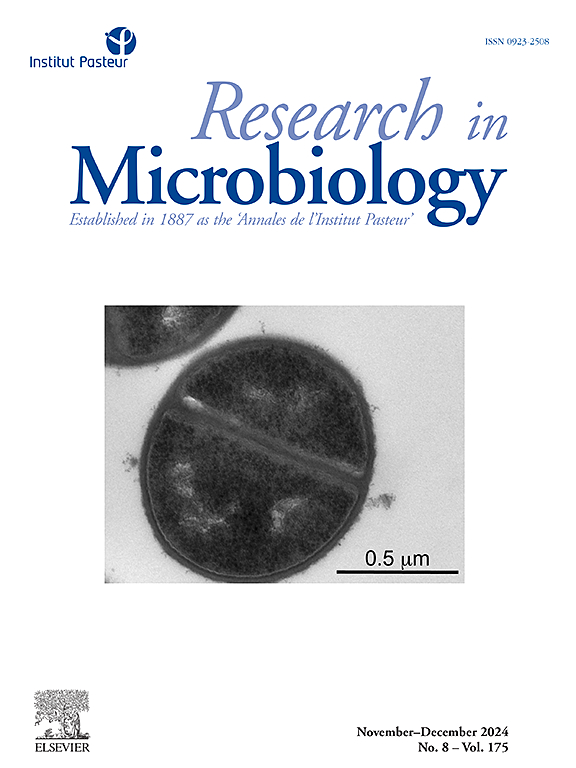2-Chloromethyl anthraquinone inhibits Candida albicans biofilm formation by inhibiting the Ras1-cAMP-Efg1 pathway
IF 3.4
4区 生物学
Q3 MICROBIOLOGY
引用次数: 0
Abstract
Candida albicans is an opportunistic pathogen, and the formation of its biofilm makes it resistant to traditional antifungal therapy. Anthraquinones have universal antibacterial activity. We evaluated the inhibitory effects of 2-chloromethyl anthraquinone on C. albicans adhesion, mycelial morphology transformation, and biofilm formation. The results showed that 2-chloromethyl anthraquinone could inhibit C. albicans adhesion, mycelium formation, and biofilm formation in a dose-dependent manner at 2 μg/mL. In addition, 2-chloromethyl anthraquinone significantly inhibited the expression of biofilm formation-related genes in C. albicans, including ALS1, CPH1, ECE1, HWP1, TEC1, BCR1, and UME6. In addition, Ras1-cAMP-Efg1 pathway-related genes (RAC1, CYR1, and TPK2) were also significantly down-regulated, indicating that the inhibitory effect of 2-chloromethyl anthraquinone on C. albicans biofilms may be related to the Ras1-cAMP-Efg1 signaling pathway. In summary, the results of this study confirmed the inhibitory mechanism of 2-chloromethyl anthraquinone on the virulence factors of C. albicans, which laid a theoretical foundation for its use as an anti-biofilm agent against C. albicans.

2-氯甲基蒽醌通过抑制Ras1-cAMP-Efg1通路抑制白色念珠菌生物膜形成
白色念珠菌是一种机会性病原体,其生物膜的形成使其对传统的抗真菌治疗具有耐药性。蒽醌类具有普遍的抗菌活性。我们评估了2-氯甲基蒽醌对白色念珠菌粘附、菌丝形态转化和生物膜形成的抑制作用。结果表明,在2 μg/mL浓度下,2-氯甲基蒽醌对白色念珠菌的粘附、菌丝的形成和生物膜的形成均有抑制作用,且呈剂量依赖性。此外,2-氯甲基蒽醌显著抑制白色假体生物膜形成相关基因ALS1、CPH1、ECE1、HWP1、TEC1、BCR1和UME6的表达。此外,Ras1-cAMP-Efg1通路相关基因(RAC1、CYR1、TPK2)也显著下调,说明2-氯甲基蒽醌对白色念珠菌生物膜的抑制作用可能与Ras1-cAMP-Efg1信号通路有关。综上所述,本研究结果证实了2-氯甲基蒽醌对白色念珠菌毒力因子的抑制机制,为其作为抗白色念珠菌生物膜剂的应用奠定了理论基础。
本文章由计算机程序翻译,如有差异,请以英文原文为准。
求助全文
约1分钟内获得全文
求助全文
来源期刊

Research in microbiology
生物-微生物学
CiteScore
4.10
自引率
3.80%
发文量
54
审稿时长
16 days
期刊介绍:
Research in Microbiology is the direct descendant of the original Pasteur periodical entitled Annales de l''Institut Pasteur, created in 1887 by Emile Duclaux under the patronage of Louis Pasteur. The Editorial Committee included Chamberland, Grancher, Nocard, Roux and Straus, and the first issue began with Louis Pasteur''s "Lettre sur la Rage" which clearly defines the spirit of the journal:"You have informed me, my dear Duclaux, that you intend to start a monthly collection of articles entitled "Annales de l''Institut Pasteur". You will be rendering a service that will be appreciated by the ever increasing number of young scientists who are attracted to microbiological studies. In your Annales, our laboratory research will of course occupy a central position, but the work from outside groups that you intend to publish will be a source of competitive stimulation for all of us."That first volume included 53 articles as well as critical reviews and book reviews. From that time on, the Annales appeared regularly every month, without interruption, even during the two world wars. Although the journal has undergone many changes over the past 100 years (in the title, the format, the language) reflecting the evolution in scientific publishing, it has consistently maintained the Pasteur tradition by publishing original reports on all aspects of microbiology.
 求助内容:
求助内容: 应助结果提醒方式:
应助结果提醒方式:


